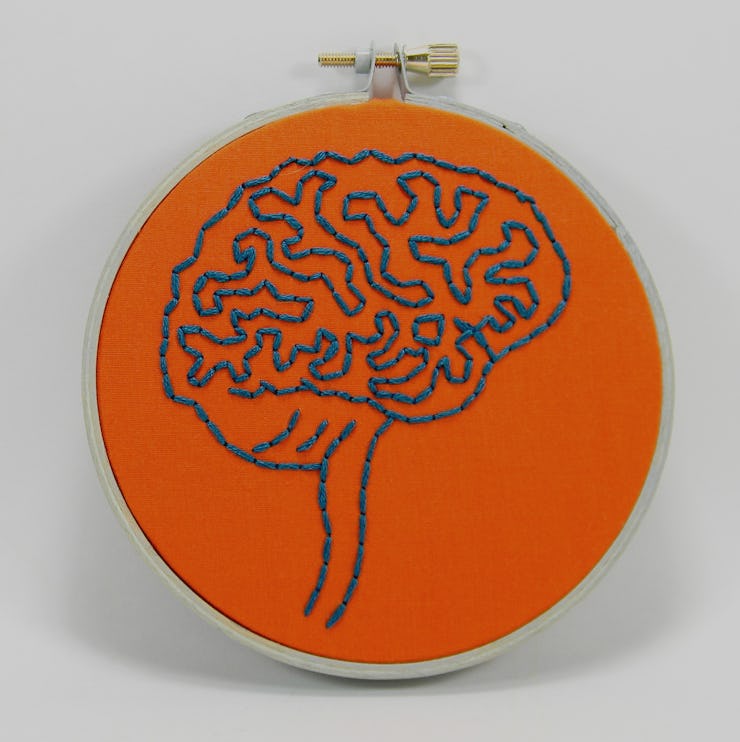In Honor of His Grandma, Teen Develops Brain-Reading Tech for Alzheimer's
Grant Sheen created his own neural network.

Before Grant Sheen’s late grandmother developed Alzheimer’s disease, she was an accountant with an talent for memorizing mathematical formulas. Her mind was sharp and her spirit fiery. Sheen, a high school senior, says that the progressive brain disorder peeled away these aspects of her identity. To her grandson, she seemed like a shell of her former self.
“Witnessing first-hand the devastation of this disease had a significant impact on me,” Sheen tells Inverse. “As a result, I began focusing my education on tackling one of the consequences of Alzheimer’s — the diminished ability to communicate.”
Sheen is one of those extraordinary people who sees a problem and then actually fixes it. The 17-year old created a software that, when paired with a wireless electroencephalogram headset (as seen in the photo), can analyze brainwave recordings.
In subsequent experiments, Sheen determined that his method for using EEG waves could predict with 90 percent accuracy whether a person wishes to eat, rest, read, or exercise. He explains that technically, this software could classify any four thoughts if there’s enough data to train his network — but these are the thoughts he felt “would be the most helpful for caretakers.”
Alzheimer’s disease causes the slow destruction of one’s memory and thinking skills. It’s the most common cause of dementia among older adults, and when it progresses into its most severe form, people can lose the ability to speak. Sheen says his tool can help these patients communicate their needs without speech.
Sheen wears a EMOTIV EPOC+ headset, which incorporates EEG technology.
Previous to his work, thought recognition devices could accurately identify three thoughts with 80 percent accuracy, in a population of subjects without Alzheimer’s. His says his model can classify four thoughts at a 95 percent accuracy in normal subjects, and at 90 percent in a group with Alzheimer’s. (Here’s his 68-page paper on it.)
“I am the first person to classify the brainwaves of an Alzheimer’s patient,” says Sheen. “I am also the first person to design a dimensionally reduced neural network for brainwave data, develop an Alternating Minimization algorithm for neural network training, and derive analytical formulas for curved decision boundaries.”
It’s easy to see Sheen’s work as novel because of the technical breakthroughs that underlie it. He coded his own neural network, because standard deep neural networks — the type that classify images and text — in Sheen’s opinion, don’t perform well when classifying wireless brainwave data, the sort that he’s pulling from the EEG.
Wireless bravewave data comes in a small amount and in low resolution, because the attention span of an Alzheimer’s patient is short, and there’s a limited number of sensors on a wireless headset. Deep neural networks, meanwhile, handle large amounts of high resolution data. So Sheen had to design his own algorithm and trained his own neural network.
But Sheen’s work is more than novel — it’s exceptional. Sheen doesn’t have a Ph.D. and decades of training. Sheen is a teenager at Sage Hill School in Newport, California. He’s applying for colleges and he’s doing homework. And when he’s not winning science competitions and building app that could help people with Alzheimer’s, he’s going to the beach, listening to music, and hanging out with friends. (He’s also a nationally ranked fencer.)
He’s also not planning on slowing down any time soon. Sheen wants pursue STEM through college and beyond, eventually pairing his socially conscious designs with entrepreneurship.
“I am interested in STEM due to its tangible impact in the world, which we can clearly see in our everyday lives,” Sheen tells Inverse. “Our world is driven by computers, which drastically accelerate computation and help us process an amount of information that would be impossible to analyze in a single lifetime. STEM allows us to improve our lives by taking innovations like computing power and making our lives more meaningful and efficient.”